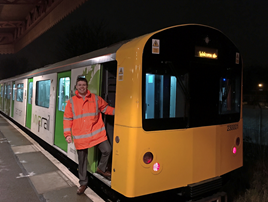By offering a technically superior and more comfortable alternative to existing stock, Vivarail hopes to demonstrate exactly why the ‘230’ has been mooted as the natural successor to the unpopular Pacers that have been earmarked for withdrawal by the end of the decade. The company is also out to impress the paying public and show that it can offer a more than worthy solution to the national shortage of DMUs, a shortage that is likely to be exacerbated by well-publicised delays to major electrification programmes around the UK.
The two driving cars are powered by two Ford ‘genset’ 3.2-litre, five-cylinder diesel engines that are part of the range more usually fitted to Transit vans. Although only capable of 60mph (compared with the 75mph top speed of a Pacer), the superior torque and acceleration of the stop-start technology gensets are thought to more than compensate for its lower speeds. The ‘230s’ also boast more impressive environmental credentials, in the form of lighter bodyshells made of aluminium while offering almost twice the fuel efficiency of Pacers.
The third trailer vehicle has been added to the prototype in the centre of the formation, to showcase a number of different interior layouts to potential clients - these include a universal access toilet, passenger information screens, LED lighting, USB points and different seating arrangements. It also shows that the ‘230s’ are fully compliant with disabled access rules, meaning that they can be operated beyond January 1 2020 (after which date Pacers must be either withdrawn or undergo necessary compliance modifications).
The ‘230s’ come with both in-cab driver-operated door controls and a control panel for the guard in the central coach. In the case of Driver Only Operation (DOO) being chosen, space has been left in the cab for retrofitting CCTV.
The cab itself has been completely stripped out and replaced from its former LU guise, and now resembles that of a Class 170. It is fully air-conditioned, and can easily be fitted with ETCS when this is rolled out across the network within the next few years.
Shooter adds: “Two coaches feature a range of different seating options, but the first coach still has the original LU layout. We thought that as they’ve been running crowded trains for years, the ‘crowd-busting’ layout was ideal for trying out on the Coventry-Nuneaton line that has the Ricoh Arena, and for other potential clients interested in shifting lots of people very quickly. You can fill it with less than 30 seconds dwell time.”
The retired former Chiltern Railways MD adds that despite rising development costs the D-Trains will still only cost roughly two-thirds of a new DMU, while they can be turned out fairly rapidly at the rate of approximately one a month from Vivarail’s current production facilities at Long Marston. He stresses that the company is primed for even faster turnouts, however, and is able to increase production accordingly to meet individual customer requirements.
Shooter would not be drawn on which operators had shown expressions of interest or placed firm orders, citing client confidentiality, but it is not difficult to speculate on the Class 230s’ potential applications on branch lines or on slow and congested commuter routes.
Unfortunately for Shooter, in April 2016 Vivarail missed out on orders for the current Northern franchise, after the Invitation to Tender (ITT) stipulated 120 new-build coaches were needed to replace the Pacers being withdrawn there. Six months later, when the new Anglia franchise was announced including wholesale fleet replacement with brand new rolling stock, Greater Anglia could not be tempted either.
But raising Shooter’s hopes will be several other franchises up for grabs between now and 2018, with ‘230s’ a possible answer to certain routes currently operated by East Midlands Trains, London Midland, South West Trains and Arriva Trains Wales. Great Western Railway could also be a contender, with the scale of the electrification and modernisation programme being heavily reined in on the Great Western Main Line amid rising costs, thereby threatening long-planned stock cascades.
‘Upcycling’ bodyshells originally built in 1980 will not meet everyone’s definition of a new train, but according to Shooter Vivarail is now gearing up to execute concrete orders, suggesting that rail passengers soon won’t only have to travel to Warwickshire to see the ‘230s’ in action.
He adds: “We do have firm orders, but they are subject to confidentiality clauses. But I can say that we will start manufacturing in January.
“I would hope that initially we can turn out a two- or three-car unit each month, but production can be shortened if we get large orders that allow us to achieve efficiencies and economies of scale.
“We have the four-track former MoD shed at Long Marston, and we are acquiring another shed in which we can fit another four to five cars. This is where they will be stripped out and cleaned up, and structural works done.
“So taking into account the existing shed, we have contingency plans to double production if needs be. There’s plenty of space at Long Marston and a dedicated test track.”















Login to comment
Comments
No comments have been made yet.